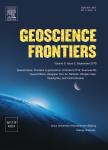Combined U-Pb SHRIMP and Hf isotope study of the Late Paleozoic Yaminue Complex,Rio Negro Province,Argentina:Implications for the origin and evolution of the Patagonia composite terrane
Combined U-Pb SHRIMP and Hf isotope study of the Late Paleozoic Yaminue Complex,Rio Negro Province,Argentina:Implications for the origin and evolution of the Patagonia composite terrane作者机构:National Scientific and Technical Research Council(CONICET)Argentina Argentine Geological-Mining Survey(SEGEMAR)Argentina ArgentineGeological-Mining Survey(SEGEMAR).Argentina University of Western AustraliaPerthWA 6009Australia Redstone Resources.Perth.WA 6849.Australia John de Laeter CentreCurtin UniversityPerthWA 6102Australia ARC National Key Centre for Geochemical Evolution and Metallogeny of Continents(GEMOC)Macquarie UniversitySydneyNSW 2109Australia
出 版 物:《Geoscience Frontiers》 (地学前缘(英文版))
年 卷 期:2013年第4卷第1期
页 面:37-56页
核心收录:
学科分类:070902[理学-地球化学] 0709[理学-地质学] 07[理学] 0708[理学-地球物理学] 0704[理学-天文学]
基 金:financial support from Research Grant PiP- 11220090100181(CONICET,Council for Scientific and Technical Research of Argentina) and SEGEMAR BSE(Back-Scattered Electrons) images were carried out using facilities at the CMCA(Centre for Microscopy,Characterization,and Analyses),which is supported by funding from UWA and the governments of Western Australia and Australia
主 题:Yaminue Complex U Pb SHRIMP geochronology Hf isotopes Tectonics North Patagonian Massif Argentina
摘 要:We have carried out zircon U-Pb SHRIMP dating and Hf isotope determinations on a biotite paraschist and on a tonalitic orthogneiss of the Yaminué Complex, and re-evaluate this complex in the broader context of the tectonic evolution of the Patagonia composite terrane. In the metasedimentary unit (msuYC), the youngest detrital zircon dated at 318 ± 5 Ma (Mississippian/Pennsylvanian boundary) indicates a Pennsylvanian (or younger) depositional age. The three main age populations peak at 474, 454 and 374 Ma. Preliminary Hf isotope data for two detrital zircons (447 and 655 Ma) yielded ε(Hf) values of -0.32 and 0.48, indicating that their primary sources contained small amounts of recycled crustal components (of Calymmian age; TDM 1.56 Ga). Zircons from the orthogneiss (miuYC; intrusive into msuYC) show a crystallization age of 261.3 - 2.7 Ma (Capitanian; late middle Permian) which is broadly coeval with deformation, and Neoarchean-Paleoproterozoic inheritance. Meaningful core-rim relationship between Neoarchean zircon cores and late Permian rims is well defined, indicating the occurrence of Archean crust in this sector of Patagonia. Hf TDM of Permian zircons is mainly Meso-Paleoarchean (2.97-3.35 Ga), with highly negative e(Hf) values (ca, -33). Hf TDM of inherited Neoarchean zircon cores is also Meso-Paleoarchean (3.14-3.45 Ga) but more juvenile (ε(Hf) = -0.3). Hf isotopes reinforce the presence of unexposed ancient crust in this area. Combining geological and isotope data, as well as geophysical models, we identify the Yaminué Complex within the La Esperanza-Yaminué crustal block flanked by two other, distinct crustal blocks: the Eastern block which forms part of the Patagonia terrane sensu stricto, located in the eastern Patagonian region, and the Western block forming part of the Southern Patagonia terrane. Their origins and timing of amalgamation to form the Patagonia composite terrane are also discussed.



